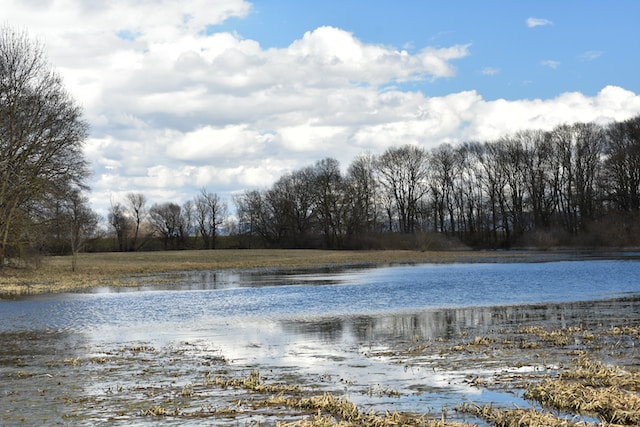Environmental Impacts of Flooding
Flooding has both positive and negative consequences. On the negative side, flood water usually contains debris and pollutants. Debris can include trees and stones, or even pieces of houses. Pollutants in flood water, such as bacteria and pesticides, can be carried long distances. Sedimentation and turbidity can result in the growth of algae and phytoplankton blooms that jeopardize water quality.
On the positive side, important nutrients and mineral deposits can also be dispersed by flood water, resulting in improved plant growth and overall ecosystem health. Over time, the nutrients, organic material, and sediment carried by flood waters and deposited on the landscape can provide fertility benefits. Furthermore, flooding can help to recharge groundwater while the soil and sediment carried by flood waters can prevent erosion and maintain river deltas [i].

Replenishment of Surface and Groundwater
One of the positive direct benefits of flooding is the replenishment of surface water and groundwater supplies. The replenishment of supplies can benefit soil, resulting in healthy crops and pastures.
Local Landscape and Habitat
Major deltas, such as the Peace-Athabasca Delta in northern Alberta [ii], the Delta Marsh in Manitoba [iii], the Okavango Delta in Botswana [iv], and the Nile delta in Egypt [v], provide very important habitats for a range of wildlife. The ongoing flooding of such deltas is essential for their health and that of their inhabitants.
Flooding can also change local landscapes and habitats. For example, John Pomeroy, a professor and water researcher at the University of Saskatchewan, explained that the 2013 Alberta floods changed the Rocky Mountains and foothills region landscape due to overflowing water, thus altering everything from how future floods will play out to how animals will build habitats in these regions [vi].
In urban areas, flooding can be extremely damaging and costly, as it can negatively impact infrastructure, homes, and businesses. In the natural environment, however, flooding has a more positive impact on the natural environment as flood water provides nourishment to the landscape [vii].
Sources:
[i] World Meteorological Organization, 2006, Associated Programme on Flood Management Technical Document No. 3, Flood Management Policy Series – Environmental Aspects of Integrated Flood Management. https://www.floodmanagement.info/publications/policy/ifm_env_aspects/Environmental_Aspects_of_IFM_En.pdf. Accessed 2023-05-26.
[ii] Regional Aquatics Monitoring Program, n.d, The Peace-Athabasca Delta. http://www.ramp-alberta.org/river/geography/peace+athabasca+delta/peace-athabasca+delta.aspx. Accessed 2023-04-25.
[iii] Government of Manitoba, n.d., Delta Marsh Wildlife Management Area. https://www.gov.mb.ca/sd/pai/mb_network/pdf/delta_marsh_backgrounder.pdf. Accessed 2023-05-26.
[iv] Africa Geographic, 2020, Understanding the Okavango Delta. https://africageographic.com/stories/understanding-the-okavango-delta/. Accessed 2023-04-25.
[v] One Earth, n.d., Nile Delta Flooded Savanna. https://www.oneearth.org/ecoregions/nile-delta-flooded-savanna/. Accessed 2023-05-26.
[vi] Livingstone, A., 2013, Alberta Floods: Assessing the human, environmental and economic impacts. https://www.thestar.com/news/canada/2013/06/24/alberta_floods_assessing_the_human_environmental_and_economic_impacts.html. Accessed 2023-05-26.
[vii] Office of the Queensland Chief Scientist, 2018, What are the consequences of floods? https://www.chiefscientist.qld.gov.au/publications/understanding-floods/flood-consequences. Accessed 2023-04-25.
